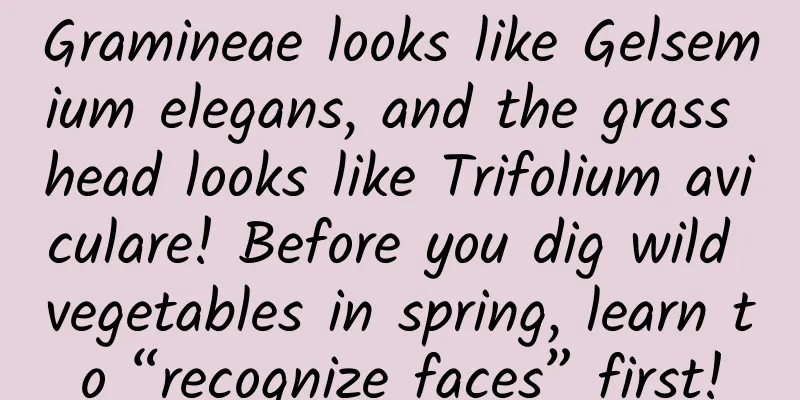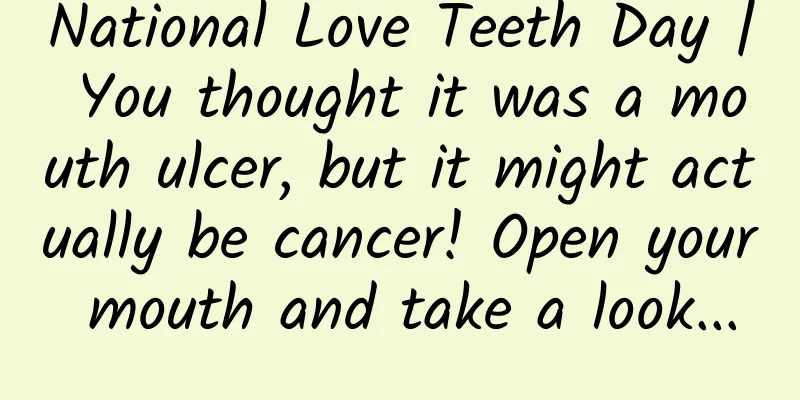Gramineae looks like Gelsemium elegans, and the grass head looks like Trifolium aviculare! Before you dig wild vegetables in spring, learn to “recognize faces” first!

|
Gotu kola, cauliflower, fern, Houttuynia cordata, wormwood, plantain, grass head... Every spring, you can see many citizens digging wild vegetables in residential areas, parks, the wild and even roadside green belts. However, are the wild vegetables you eat really safe? (Picture from the Internet) You thought you were digging delicious It's actually a poisonous weed! In recent years, monitoring has found that incidents of poisoning caused by accidentally eating wild vegetables, fruits and other wild plants in the spring occur frequently. The Guangxi Disease Control Department reminds that as the weather warms up and humidity increases in spring, various bacteria are able to multiply in large numbers and various wild plants gradually mature. This is the peak season for bacterial and plant food poisoning . Plantain. Source: Nanning Evening News In April 2022, during the Qingming Festival, a poisoning incident occurred in a county in Chongzuo City, Guangxi Province, where 9 people were mistakenly picked and eaten wild vegetables. 3 of them were sent to the ICU for emergency treatment . Fortunately, they ate less and saved their lives. The cause of the poisoning was that the citizens mistakenly ate the herb Gnaphalium as "Dragon's Beard Vegetable" , which led to poisoning. Source: Guangxi Disease Control Shi Xiangdong, chief technician of nutrition and food hygiene at the Nanning Center for Disease Control and Prevention, said that poisoning caused by eating wild plants by mistake can cause dizziness, nausea, vomiting, abdominal pain, diarrhea , and even numbness of the lips and limbs, general weakness, blurred vision, difficulty breathing, convulsions, coma, etc., depending on the amount of food eaten. In severe cases, the person may be life-threatening. The grass head (left) and the white clover (right) are very similar. Although the white clover can also be eaten, it is often used as medicine. As the saying goes, "all medicines are poisonous", eating too much is always risky. (Internet photo) If symptoms of poisoning occur, citizens should go to the hospital for treatment in time , tell the doctor the wild plants they have eaten, and save the remaining food for investigation and tracking; if medical treatment is not possible in time, they should immediately find a way to induce vomiting and drink plenty of warm water to help excrete toxins from the body. Eating poisonous wild vegetables may cause poisoning Even if the wild vegetables you eat may not be poisonous There is also the problem of excessive heavy metals Do you still think it’s worth a taste of the “freshness”? "Nutritional Composition and Heavy Metal Analysis of Four Wild Vegetables in Nanjing Suburbs" (Internet Photo) Which wild vegetables should never be eaten? It is best not to pick wild vegetables that you don’t recognize, and it is best not to eat wild vegetables that you are not sure of , to prevent unnecessary accidents. Wild vegetables growing in grasslands and along roadsides where industrial wastewater flows are contaminated and contain high levels of harmful substances such as mercury, lead and other heavy metals. Do not eat these contaminated wild vegetables to prevent poisoning. Wild vegetables must be fresh, and it is best to eat them immediately after picking them . Wild vegetables that have been stored for a long time are not only not fresh, but also have reduced nutritional value and taste very bad. Some wild vegetables need to be soaked . For example, some wild vegetables such as yam and wild garlic contain slight toxins. They must be soaked in clean water for more than two hours and detoxified before cooking. The eating of wild vegetables varies from person to person . Patients with gastrointestinal diseases or high blood viscosity should not eat too many wild vegetables. Wild vegetables are high in dietary fiber, and infants and young children have weak digestive abilities, so they should not eat too much. People with allergies also need to be very cautious when eating wild vegetables. Gelsemium elegans is poisonous (left), while Senecio radiata is non-toxic (right). In 2016, a retired doctor in Nanning, Guangxi, mistook Gelsemium elegans for Senecio radiata and collected it to make soup, resulting in two people being poisoned and one person dying. Source: Guangxi Disease Control Look carefully! These wild vegetables are poisonous Once again, we remind everyone to be cautious when eating wild vegetables! Source | Popular Science, People's Daily |
<<: Following the light: He uses "photon imaging" to illuminate the biological world!
>>: In the story of the carp leaping over the dragon gate, which one of them is it?
Recommend
[Ten thousand words of heavy and in-depth] The strange current situation of the smart TV industry witnessed in the past ten years
Just like newspapers are leaving us, the TV indus...
Beijing Film Festival will be held on August 22 (with original text)
The 10th Beijing International Film Festival will...
What licenses do e-commerce websites need?
The past 10 years have been the golden age of e-c...
Stop eating like a glutton! These types of people should pay special attention →
Review expert: Wang Xuejiang, professor at Capita...
Qu Shanshan’s personal profile: What role does the robots.txt text of a website play in optimization?
Many webmasters will implement robots protocol fo...
Chinese scientists store Chinese characters in DNA! How will DNA storage develop in the future?
Recently, a team of teachers and students from So...
How should Tik Tok create a hit? Official TikTok hit tips!
The rise of short videos has brought countless ne...
Tooth extraction can really kill you! From hammering teeth to minimally invasive techniques, here's a look at the evolution of human tooth extraction surgery!
Tooth extraction is a "terrifying" oper...
Say no to choice difficulties, AI can help you choose clothes!
Produced by: Science Popularization China Author:...
Tips for promoting products on Xiaohongshu!
Tips for promoting products on Xiaohongshu : How ...
How did the most silent organ in the body turn into a killer?
【Written at the end】 In 2020, more than 410,000 p...
Operations experts tell you: the mentality, skills, and thinking patterns required for operations!
I have indeed come into contact with many young p...
Xiaomi Auto sets its first FLAG for 2025 - to deliver 300,000 vehicles. Whose share will be eaten up?
After entering the stock market, if anyone in the...
What’s the secret to quickly gaining followers on Douyin? A must-see for operations!
The sudden outbreak of the epidemic in 2020 destr...
How much does it cost to customize the Linyi wine and beverage mini program? Linyi wine and beverage applet customized price inquiry
There are two types of customization of Linyi Liq...









